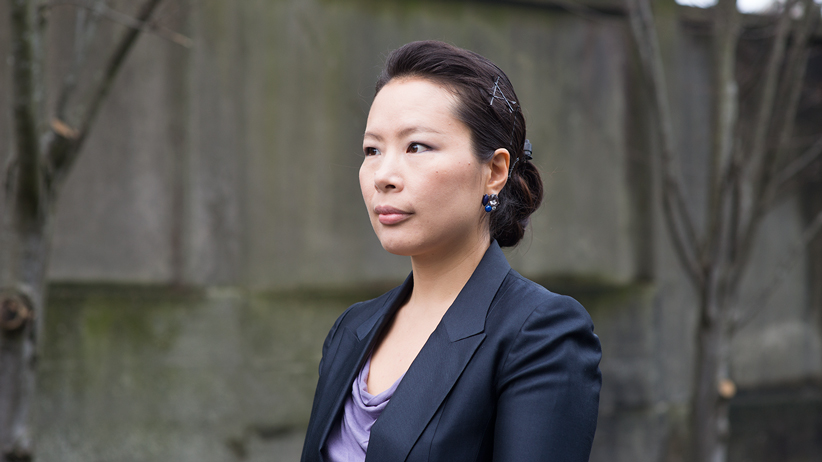The real vaccine scandal
It’s not just the anti-vaxxers—Canada’s vaccination system is a mess. How governments and parents are failing our kids.
Share
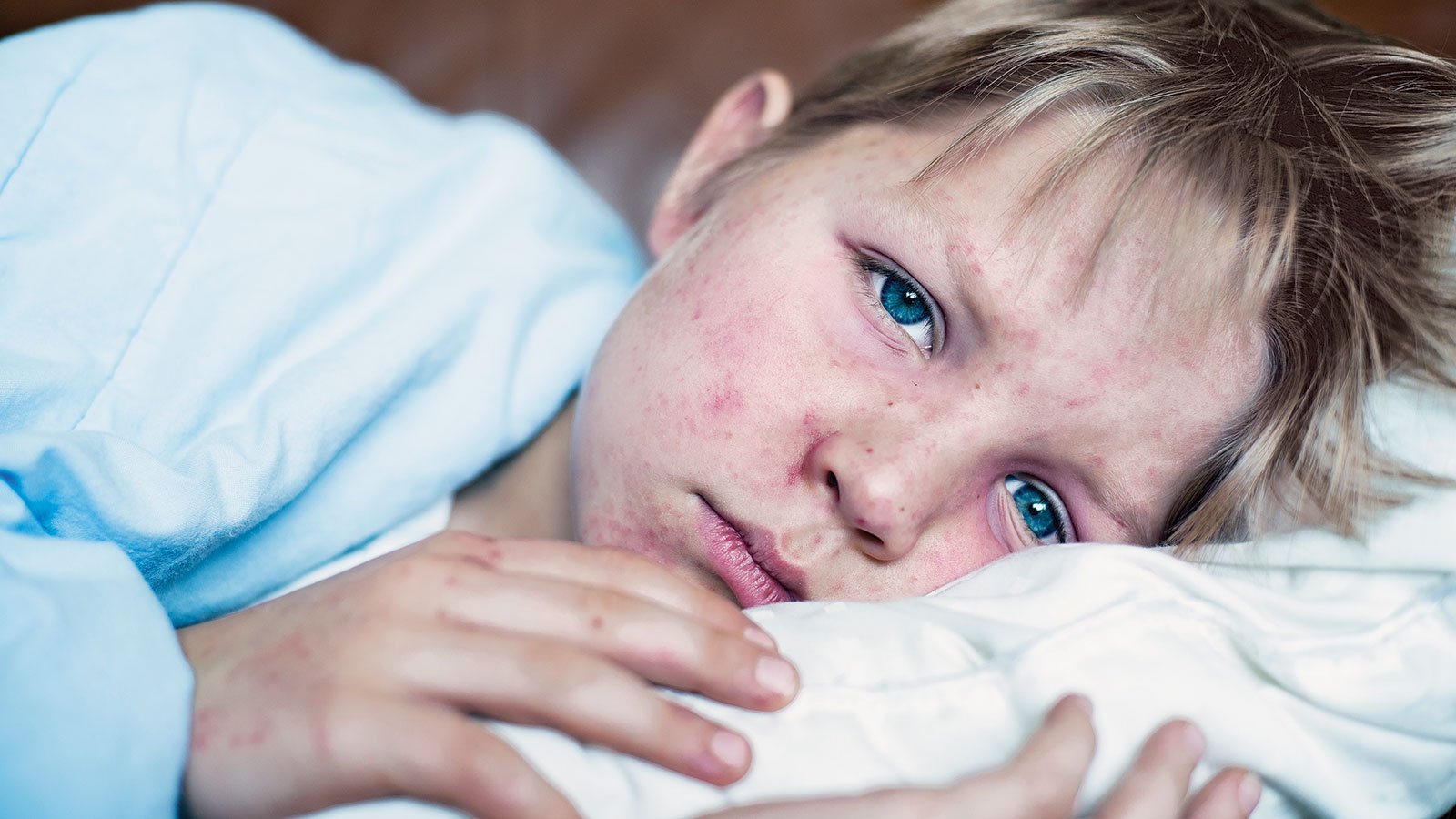
Dr. Victoria Lee and her colleagues saw measles coming well before it struck B.C.’s eastern Fraser Valley last March. The virus was headed their way like a runaway train careening down a track—and hundreds of people were standing between the rails, refusing to budge. Anti-immunization beliefs flourish in many of the small religious communities that dot the countryside in what’s known as B.C.’s Bible Belt. Overall, about 70 per cent of two-year-olds in the Fraser Valley had all their recommended shots, but in some places vaccine coverage is close to zero. And with members of some churches in the Dutch Reformed tradition regularly travelling back and forth to the Netherlands, where measles had been on the loose for months, infecting 2,600, landing 182 in hospital and killing one child, it was only a matter of time before an unvaccinated traveller brought the virus home. “We were monitoring pretty closely. We take even one case seriously,” Lee says.
But all the watchfulness in the world couldn’t prepare her for the difficulties that lay ahead. Measles is one of the most contagious diseases known to science. The virus, which causes high fever, weakness, flu-like symptoms and a conspicuous red rash, spreads through the air and hangs around even after a sick person has left the room. Come within sneezing distance, unprotected, and there’s a 90 per cent chance you’ll catch it too. In an unvaccinated population, the average patient will pass it to 11 to 18 others, oftentimes during the week or two before they themselves start to show symptoms.
When measles finally did pop up at Mount Cheam Christian School in Chilliwack, B.C., on March 10, 2014, the emergency team at Fraser Health, the local authority, sprang into crisis mode. The school, which is affiliated with the Reformed Congregations of North America—a small, conservative sect whose pastor has publicly stated that the risk of infectious diseases should be left in God’s hands—was voluntarily closed as an emergency measure. The sick were isolated; vaccination clinics hastily organized. Lee, who was director for population and public health at the time, felt like she was a cast member on CSI.
“It was an intense time,” she recalls. For weeks she huddled every day with a team of doctors, epidemiologists and community leaders, poring over cases and trying to link them together. She spent hours on the phone advising anxious doctors and public health nurses, many of whom had never seen measles before and had to dig out old medical textbooks to try and make a diagnosis.
By the time Fraser Health declared the outbreak over, four weeks later, more than 400 people had fallen ill. Most of the patients were young—the average age was 11. No one died, but there were serious complications: three cases of pneumonia, one incident of encephalitis (a potentially life-threatening swelling of the brain), and a report of fever-induced seizures.
Still, Lee considers it a success. “I know,” she says with a sigh. “It’s like, success? With 400 cases? But from a public health perspective, it was. Transmission remained within the communities that do not vaccinate.” In fact, only four people who were not part of the religious group caught the measles, and only one was known to have had all their shots.
Related reading: What Cuba can teach us about vaccines
Half a century ago, measles was nearly as common as a cold, infecting 300,000 to 400,000 Canadians annually. Most who caught it soon recovered, but it was never benign, causing 5,000 hospitalizations, 400 cases of encephalitis and 50 to 75 deaths in an average year. Today, the disease still infects 20 million people a year globally, mostly in the developing world. Measles remains a leading cause of blindness and deafness. And it kills 140,000 a year, most under the age of five. ![]() tweet this
tweet this
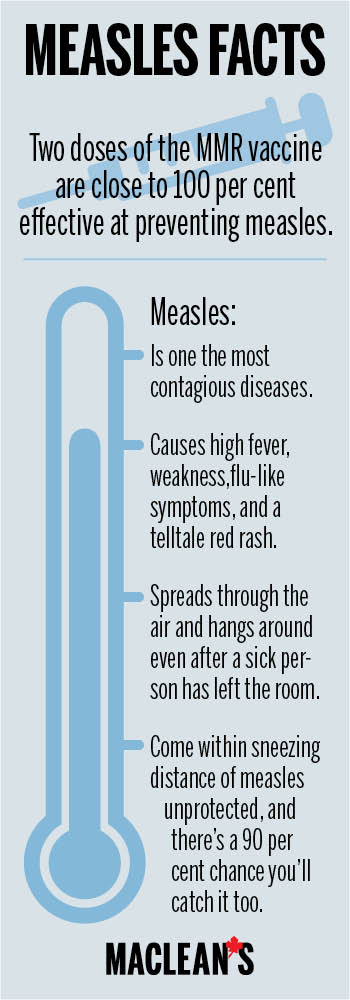 In the fortunate First World, measles should no longer be a problem. Two doses of the MMR (measles, mumps and rubella) vaccine are close to 100 per cent effective at preventing the disease. (Until the mid-1990s, children only received one dose at age one, but it was determined that didn’t offer full protection. Now a second dose is administered before children turn seven.) The vaccination was such a success that back in 2002, the World Health Organization declared measles eradicated from the whole of the Americas after 12 uninterrupted months passed with no new infections.
In the fortunate First World, measles should no longer be a problem. Two doses of the MMR (measles, mumps and rubella) vaccine are close to 100 per cent effective at preventing the disease. (Until the mid-1990s, children only received one dose at age one, but it was determined that didn’t offer full protection. Now a second dose is administered before children turn seven.) The vaccination was such a success that back in 2002, the World Health Organization declared measles eradicated from the whole of the Americas after 12 uninterrupted months passed with no new infections.
Every domestic outbreak since has been imported from overseas. But lately, the virus has been making a worrying comeback. In 2011, Quebec had to contend with a cluster of 776 cases: 85 people were hospitalized, and 60 had “serious complications.” In 2014, the United States hit a 20-year high for measles with 644 cases across 27 states. This year is off to an equally dire start, with more than 100 cases reported so far, the majority linked to a single infected visitor to California’s Disneyland theme park in the busy week before Christmas. As of this week, Ontario was contending with seven measles cases; Quebec had eight, and Manitoba one. Almost all of them share the same common factor—the patients were either entirely unprotected, or had received just one dose of the vaccine.
Anti-immunization enclaves like those in B.C.’s Bible Belt are a chink in the immunization armour that shields Canadians from devastating epidemics. But at least they are easy to find and isolate. As worries about vaccines have begun to spread into the mainstream, however—propelled by Hollywood celebrities, conspiracy theorists and practitioners of alternative medicine—other less fixable weaknesses are being exposed. Only two provinces—Ontario and New Brunswick—legally oblige parents to vaccinate their children against preventable diseases in order to attend school, and their efforts to track compliance are rudimentary.
For a curated feed of Maclean’s best stories, visit us on Facebook.
Canada’s muddle of 14 provincial, territorial and federal health bureaucracies can’t even really say who has been immunized and against what. Where kids get their shots and who gives them varies wildly. Depending on where you live, public health units, school-based clinics, or family doctors may take on the responsibility. Despite a decade of trying and hundreds of millions of dollars spent, the country still doesn’t have a workable, national computerized vaccine registry.
Meanwhile, millions of Canadian adults born between 1970 and 1992 fall into the “not fully protected” category, too old to have received a second dose of MMR as a child, but too young to have gained natural immunity through exposure to the disease in the pre-vaccine era. With the effects of the relatively small anti-vaccination movement amplified by people who are too lazy or complacent to keep their immunizations up to date, other long-vanquished diseases, like mumps and whooping cough, are already roaring back.
Real, widespread danger is lurking. The idea behind mass vaccination is not to achieve 100 per cent participation, but rather the 95 per cent or so needed to stop diseases spreading unchecked, providing the public with so-called “herd immunity.” The figures that Canada supplies to the World Health Organization state that 95 per cent of kids have been protected against measles, but that’s something between an estimate and a guess, based on surveys and telephone polls that are far from comprehensive. It won’t be difficult to tell when we drop too far below that line, says Dr. Gerald Evans, chair of infectious diseases at Queen’s University’s medical school.
“Ultimately, what will happen if you get outbreaks where 500 to 1,000 people are infected, you’re going to start seeing deaths. And you’re going to start seeing some of the less common complications,” he says. Evans lays the blame on the wilfully ignorant. “The anti-vax movement is probably one of the greatest risks to the health of our population in terms of infectious diseases,” he says. Dealing with the repercussions, however, will be everyone’s responsibility.
The practice of deliberately exposing ourselves to diseases to build up an immunity has been around for at least a thousand years. Modern vaccines can trace their roots to Edward Jenner, an English physician who began using cowpox—a disease that milkmaids got from infected udders—to protect against deadly smallpox in 1796. But the idea of inviting a small illness into the body to fend off a greater one has never found full acceptance. History is littered with examples of plagues that were rooted in fear and suspicion. Take the case of Montreal in 1885, when a series of allergic reactions to a bad batch of smallpox vaccine set off a nationalistic anti-immunization movement among francophones, based on the idea that the English were trying to poison them. The ensuing outbreak saw 20,000 cases of the disease and 2,700 fatalities. More than 85 per cent of the victims were under the age of 10.
Today’s anti-vaccination movement had similarly modest beginnings; a single 1998 study positing a link between the MMR vaccine and autism. No one was ever able to replicate its findings and the paper was ultimately retracted by The Lancet medical journal in 2010, after its author was found to have deliberately falsified his data in pursuit of personal financial gain. But by then, the lie had taken hold, and been magnified by dozens of other vaccine concerns and conspiracies; none of them scientifically substantiated in the slightest.
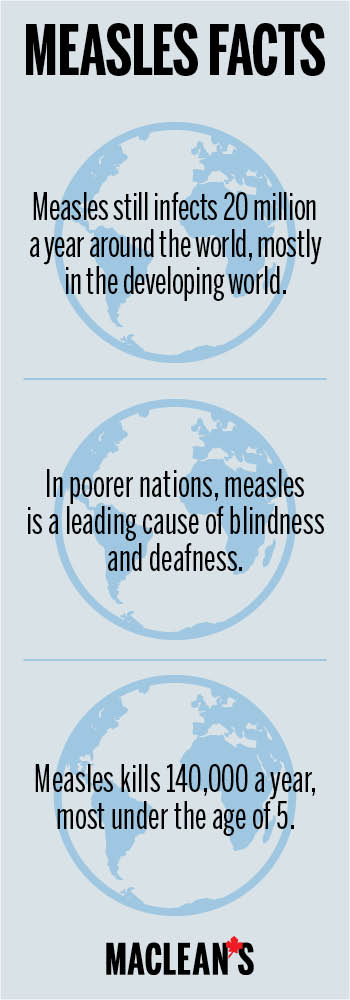 In the U.S. the spread of anti-vaccination beliefs has been particularly dramatic. Although every state requires that children receive the MMR vaccine, along with other immunizations against common childhood diseases before starting school, all offer exemptions for medical or religious reasons, and 20 now also allow parents to opt out simply for “personal beliefs.” Over the last four school years, exemption requests have jumped by 37 per cent, the Center for Disease Control reports, and in states like Michigan, Vermont, Oregon and Idaho, more than six per cent of kindergarten students are currently unvaccinated. Those numbers are big enough to give vote-hustling politicians reason to pay lip-service to the anti-vaxxers. “Parents need to have some measure of choice in things,” New Jersey Gov. Chris Christie, a would-be candidate for the 2016 Republican nomination, said recently. Rand Paul, an ophthalmologist-turned-Kentucky senator who harbours similar ambitions, went even further, declaring that he knows of “many tragic cases of walking, talking, normal children who wound up with profound mental disorders after vaccines.”
In the U.S. the spread of anti-vaccination beliefs has been particularly dramatic. Although every state requires that children receive the MMR vaccine, along with other immunizations against common childhood diseases before starting school, all offer exemptions for medical or religious reasons, and 20 now also allow parents to opt out simply for “personal beliefs.” Over the last four school years, exemption requests have jumped by 37 per cent, the Center for Disease Control reports, and in states like Michigan, Vermont, Oregon and Idaho, more than six per cent of kindergarten students are currently unvaccinated. Those numbers are big enough to give vote-hustling politicians reason to pay lip-service to the anti-vaxxers. “Parents need to have some measure of choice in things,” New Jersey Gov. Chris Christie, a would-be candidate for the 2016 Republican nomination, said recently. Rand Paul, an ophthalmologist-turned-Kentucky senator who harbours similar ambitions, went even further, declaring that he knows of “many tragic cases of walking, talking, normal children who wound up with profound mental disorders after vaccines.”
Canadians might dismiss those numbers and that type of political posturing as more proof of the folly of America’s fetishization of individual rights—like laws that let gun owners bring assault rifles to restaurants. In this case, however, there’s little reason to be smug. The two provinces that have “mandatory” immunization all offer parents similar exceptions, obtained with similar ease. More than a dozen Toronto public schools have opt-out rates in the double digits for MMR and the DTP vaccine, which protects against diphtheria, pertussis (commonly known as whooping cough) and tetanus, with one, Alpha Alternative Junior School, clocking in at 39.5 per cent. (According to the Public Health Agency of Canada, 4,500 Canadians, mostly children, developed pertussis in 2012.) A series of polls released in early February by Mainstreet Technologies found that 20 per cent of respondents in Ontario and Saskatchewan, and 21 per cent in Alberta, believe that the MMR vaccine might cause autism—a theory that has been thoroughly and repeatedly discredited by researchers. While a majority in all three provinces believe that schools and childcare facilities should turn away unprotected children, there is strong support for the idea that parents should have the ultimate say on whether or not to vaccinate—56 per cent in Alberta, 55 per cent in Saskatchewan and 30 per cent in Ontario.
In a way, the concerns and backsliding we are now seeing now are measures of our public health success. More than a generation removed from widespread epidemics of vaccine-preventable diseases, anti-immunization crusaders are able to focus on the exceptions, not the rules. “The anti-vax movement is so good, frankly, at telling heart-wrenching stories,” says Shelley Deeks, head of vaccine-preventable diseases at Public Health Ontario. ![]() tweet this “In the scientific community we shy away from stories because they’re not scientific. But a number of us have seen devastating cases of vaccine-preventable diseases.”
tweet this “In the scientific community we shy away from stories because they’re not scientific. But a number of us have seen devastating cases of vaccine-preventable diseases.”
MEASLES OUTBREAKS IN CANADA
Though measles has been eradicated in North America in 2002, eight provinces have been hit by measles outbreaks since 2011. To activate the interactive map, scroll over it and tap the locators to see a breakdown of each province’s diagnoses, and four major outbreak zones.

They are also remarkably resistant to efforts to sway their opinions. In another recent paper, published in the journal Pediatrics, American researchers tested the effectiveness of four different pro-vaccine messages—ranging from gentle reminders to scary pictures of children suffering from measles, mumps or rubella—on anti-vaxxers. All of the tactics failed to change anyone’s mind, and the more pointed ones seemed to backfire, reinforcing worries about autism and side effects, and reducing the likelihood that already-worried parents would ever consider vaccinating their kids. “Attempts to increase concerns about communicable diseases or correct false claims about vaccines may be especially likely to be counterproductive. More study of pro-vaccine messaging is needed,” the authors wrote. 
Kahan’s study of anti-vaxxers, which also looked at communication strategies, identified an even more troubling problem. All the public education campaigns and media reports actually appear to be undermining immunization efforts by causing people to overestimate the number of exemptions being granted. “Motivation to contribute to collective goods, such as the herd immunity conferred by mass vaccination, declines when members of the public perceive that others are refusing to contribute,” Kahan warns.
Scott Halperin, a professor of pediatrics at Dalhousie University and head of the Canadian Centre for Vaccinology, often deals with parents who have concerns about immunization. He hasn’t seen much of a change in the number of hardcore anti-vaxxers who are referred to his office by family doctors, but says he has seen an increase in those he would categorize as “mildly hesitant.” He says, that “there are more people who are confused. There’s a lot of scary info on the Internet.” Halperin’s main approach is to listen rather than preach. “People who are hesitant are hesitant for a reason,” he says. “You have to understand their concerns.” About half of the “hesitants” he sees agree to immunize their kids right away; the remainder need more time and convincing. What’s important, says Halperin, is that the medical community doesn’t give up. “These people aren’t against vaccines. They just think that they don’t really need them,” he says. “We have to get across to these people that the fact that they are not seeing these diseases is good news. You shouldn’t need to have a fire to understand that you want fire insurance for your house.”
David Ropeik, a Boston-based author and consultant who specializes in risk communication, says health authorities have failed in two major ways: by not contradicting the autism claims aggressively enough when they first surfaced a decade ago, and, more recently, being too dismissive of people’s worries. In an age of government scandal and corporate malfeasance, the public’s mistrust is not entirely unfounded, he stresses. “It is rational for us to use everything we can to survive and protect our safety, including our intuition,” says Ropeik. The old model of relying on high-profile experts and national leaders to get across a message no longer works when even the smallest problem can mushroom into a global concern via the Internet. Instead, Ropeik says health officials should be lower key, quicker to respectfully refute challenges, and look for trusted, local champions—all the while making it harder for anti-vaxxers to opt out. “The goal isn’t to change everyone’s mind. It’s to change enough minds to get above herd immunity levels,” says Ropeik.
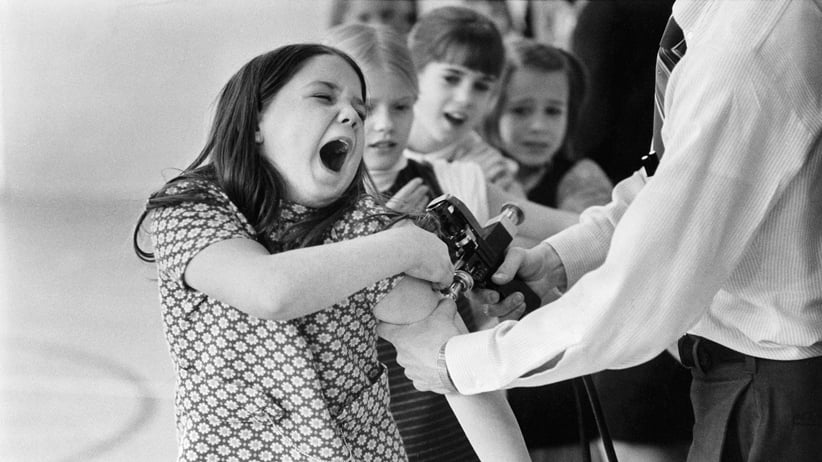
Those worrying about what might lie in store for Canada and the United States when it comes to measles need look no further than Europe. Last year, there were close to 3,900 cases on the continent, which was a big improvement from 2013, when the number topped 10,000. France alone has had more than 23,000 cases over the past five years. And a dozen deaths. According to the World Health Organization, 89 per cent of French seven-year-olds have received their two MMR shots. The similar figure for Canada is said to be 95 per cent. But it really depends on who you believe. The most comprehensive national data we have, from a federal report on immunization, is more than a decade old and suggests Canada’s numbers might actually be even lower than France’s—with only 79 per cent of seven-year-olds fully protected. In Manitoba, which has the most sophisticated tracking system, the coverage figure was just 76 per cent in 2013. In Ontario and B.C., which have numbers up to 2012, it is said that 88 per cent of kids of a similar age are fully protected. The latest Statistics Canada telephone and mail survey for 2013 was supposed to be released last fall. So far, there’s no sign of it.
Join the conversation on our Facebook page.
The need for a national public health surveillance system, including a computerized vaccine registry, was one of the key recommendations that came out of the 2003 SARS crisis. Comprehensive immunization monitoring is already being done in a number of wealthy nations, including Australia and Singapore. In March 2004, the federal government assigned Canada Health Infoway, a government-funded non-profit organization, to develop a national disease surveillance system. According to IBM Canada, which is working on the project, it is meant to allow health officials to “view immunization history for individuals and populations as well as lists of clients who are eligible or overdue for vaccinations by vaccine of interest, demographics, and/or risk factors.” Since then, $135 million in federal money have been provided for the project. But the Canada-wide database still isn’t a reality. Individual provinces have adopted the technology for their electronic record systems. Alberta and the four Atlantic provinces aren’t even participating. In many parts of the country, vaccinations continue to be tracked the way they were decades ago—via yellow paper cards filled out by physicians. It’s up to parents to transmit the information to local health units. “Initially there was sort of this idea that we could have a national registry or national database. That just isn’t possible in Canada,” Dr. John Spika, director general of the Public Health Agency of Canada’s centre for immunizations and respiratory infectious diseases says frankly. “There are too many issues related to privacy laws that would prevent that from happening.” 
The failure to follow through on promises of a national database underscores other problems in the system. There could well be a pocket of jaw-droppingly low vaccination coverage in your city or even neighbourhood, but there’s no way to know for sure. “We don’t have that information in our database, and unfortunately, there are very few jurisdictions, if any, that have the ability to get down to that level,” says Spika.
One large weakness in our defence is the group of adults who received only one dose of the MMR vaccine, instead of the recommended two. Evans of Queen’s University estimates that the total number of Canadians who could catch measles—because they’re less than one year old, or they can’t or won’t be vaccinated, or they aren’t fully protected because they have had only one shot—amounts to 10 to 15 per cent of the population. That’s three to five million people, leaving the potential open for a large outbreak. Identifying even those young adults and bringing them up to date with their shots would be a Herculean task. Young, healthy adults who don’t go to the doctor regularly are “impossible to reach,” notes Evans. Hockey fans are already familiar with that hole in our vaccine net. So far this season, more than 20 NHL players, including Pittsburgh superstar Sidney Crosby, have been infected with the mumps. Most hadn’t received the second dose of the MMR vaccine.
Canada has no national immunization strategy—all provinces vaccinate against a standard set of childhood diseases, but there’s some variability in what’s offered for free and at what age the vaccines are given. That’s another obvious failing, since infectious diseases rarely respect borders. When herd immunity isn’t quite up to scratch in a community surrounding a pocket of unprotected people, that’s a recipe for a large-scale outbreak. “It all depends on the susceptibility of the population where it starts, where the virus enters,” says Shelley Deeks of Public Health Ontario. Ultimately, those gaps will allow measles and other preventable diseases to again take hold and begin spreading in our hemisphere.
Efforts are under way to address the problems and sidestep bureaucratic inertia. Dr. Kumanan Wilson, a senior scientist at the Ottawa Hospital Research Institute, has developed a free smartphone app, ImmunizeCA, that stores vaccination information, reminds parents when shots are due and warns of outbreaks in your area. Future versions will scan the bar codes on vaccine vials and enable parents to send the information to public health authorities, cheaply providing the kind of tracking that governments seem unable to gather.
For the moment, without vaccination, our first line of defence against 21st-century outbreaks remains the 19th-century tools of isolation and contact tracing. In the Fraser Valley, Victoria Lee and her team know that it’s only a matter of time until the next vaccine-preventable disease hits their community. “Unfortunately we do have a large number of vulnerable people who are not vaccinated,” she says. The threat could be something worse than measles next time.
During the 2014 measles outbreak, her team decided not to push vaccination too hard for fear of getting people’s hackles up. A go-between medical professional with a Dutch Reform background was appointed to communicate with the religious community. Medical officers even attended a science fair held at Mount Cheam after the outbreak was over. There were projects about the history of vaccination and the eradication of smallpox, but not a single one portrayed current vaccines in a positive light. Even personal experience with the nastier aspects of measles couldn’t convert the hardcore doubters to a pro-vaccination stance.
As long as the anti-vaccination movement remains strong, and our collective response weak, the sad reality for Canada is that other large outbreaks are inevitable. History shows that epidemics do solve part of the problem, sending the vaccine-hesitant and the chronically lazy running towards the nearest needle. “Fear isn’t a good motivator, but sometimes it works,” says Dalhousie’s Scott Halperin. Yet it does so at a steep cost in terms of damaged, disfigured and sometimes dead children and adults. “We need to do is figure out how to make immunization part of people’s DNA,” says Halperin. “Vaccines should be something that people are demanding, that they consider one of their rights.” Because now it’s a right that far too many people are denying their kids.

